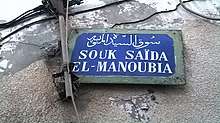Aisha Al-Manoubya
AÏsha Al-Manoubya (Arabic: عائشة المنوبية, ʿĀʾisha al-Mannūbiyya), also known by the honorific Al-Saida ('saint') or Lella ('the Lady') (1199–1267 CE), is one of the most famous women in Tunisia, and a prominent figure in Islam.

ʿĀʾisha was known for her Sufism and good deeds. She was the supporter and student of Sidi Bousaid al-Baji and Abul Hasan ash-Shadhili. Her presence as a woman on the high level of education and advocacy activity and charity event was very unusual in her time.
Life
Dates given for ʿĀʾisha's life vary slightly, but scholarly sources give 1199–1267 CE (595–665 AH).[1]
According to her hagiography, ʿĀʾisha was born in the village of La Manouba (al-Manūba), near Tunis, and showed signs of her saintliness already in childhood, challenging social norms and effecting miraculous deeds (karamāt). In portraying ʿĀʾisha's socially transgressive behaviour, her saint's life 'aligns her with the Ṣūfī model of the “blamable ones” (ahl al-malāma), those who went about transgressing social norms on purpose'.[2] Among her most famous deeds, 'after her father had slaughtered a bull at her request, she cooked it, distributed its meat to villagers, and brought it back to life in order to reveal her sainthood. This event is regularly commemorated in song during rituals held at her shrines'.[2]
ʿĀʾisha studied in Tunis with Shādhiliyya Ṣūfīs, moving back and forth between her rural home and urban Tunis. Prominent influences were the female mystic Rābiʿa al-ʿAdawiyya al-Qaysiyya (c. 95/714–185/801); Abū l-Ḥassan al-Shādhilī (c. 593–656/1196–1258), who founded the Shādhilī Ṣūfī order; the Baghdadi ʿAbd al-Qādir al-Jīlānī (470–561/1077 or 1078–1166, of Baghdad, namesake and patron of the Qādiriyya); and al-Junayd (d. 297/910), a Shāfiʿī scholar associated with Baghdad but of Persian origin.
ʿĀʾisha is one of the few women to have been the subject of a written saint's life (manāqib) in the Islamic world of her time, and 'represents a leading figure of women’s sainthood in Islam'. Whereas it was customary for female saints in her region to be recluses, ʿĀʾisha mixed with male society, whether the poor; Sūfī scholars; or even the Ḥafṣīd sultan. She had two shrines dedicated to her, one in La Manouba (destroyed in 2012) and the other in the Gorjani district of Tunis.[2]
Her commemoration
In popular memory, ʿĀʾisha represents a powerful and respected saint. One of the souks of the Medina of Tunis, "Souk Al-Saida Al-Manoubya", was named after her.[3]
A few kilometres from the Medina, a popular neighbourhood, Gourbivilles, takes her name.[4] Al-Manoubya used to retire to pray in that neighbourhood.[5]
The inhabitants of Manouba built a second mausoleum to commemorate ʿĀʾisha under the name of "The Mausoleum of Al-Saida Al-Manoubya" in her birthplace area.[6] That mausoleum is very famous and has a big value in the Tunisian national heritage and history. It was vandalised and burned after the Tunisian Revolution, on 16 October 2012.[7][8][9][10]
Primary sources
- Manâqib al-Sayyida ‘Â’isha al-Mannûbiyya (Tunis 1344/1925)
- Nelly Amri, La sainte de Tunis: Présentation et traduction de l'hagiographie de ‘Â’isha al-Mannûbiyya (m. 665/1267) (Arles: Sindbad-Actes Sud, 2008)
- '‘Âisha al-Mannûbiyya (v. 1198-1267)', in Audrey Fella, Femmes en quête d'absolu: Anthologie de la mystique au féminin (Michel, 2016)
Secondary studies
Many books[11][12] and studies[13] have discussed ʿĀʾisha's history. So too have cinema and Sufi songs and performances.[14] The main scholarly studies of ʿĀʾisha are:
- Amri, Nelly, 'Femmes, sainteté et discours hagiographique au Maghreb médiéval: Naissance à la sainteté, naissance à l'histoire; Le case d'une sainte de Tunis, ‘Â’isha al-Mannûbiyya (m. 665/1267)', in Histoire des femmes au Maghreb: Réponses à l'exclusion, ed. by Mohamed Monkachi (Morocco: Faculté des Lettres de Kénitra, 1999), 253-74. Amri, Nelly, Les Femmes soufies ou la passion de Dieu (St-Jean-de-Bray: Dangles, 1992)
- Abū ‘Abd al-Raḥmān al-Sulamī, Early Sufi Women: Dhikr an-Niswa al-Muta’abbidat as-Sufiyyat, trans. by Rkia Cornell (1999)
- Katia Boissevain, Sainte parmi les saints. Sayyida Mannūbiya ou les recompositions cultuelles dans la Tunisie contemporaine (2006)
References
- Nelly Amri, La sainte de Tunis. Présentation et traduction de l’hagiographie de ʿĀisha al-Mannūbiyya (Arles: Sindbad-Actes Sud, 2008).
- Katia Boissevain, 'al-Mannūbiyya, Sayyida ʿĀʾisha', in Encyclopaedia of Islam, THREE, ed. by Kate Fleet and others (Leiden: Brill, 2012-), consulted online on 29 June 2017 <https://dx.doi.org/10.1163/1573-3912_ei3_COM_24813>.
- Slyomovics, Susan (5 November 2013). The Walled Arab City in Literature, Architecture and History: The Living Medina in the Maghrib. Routledge. ISBN 9781135281267.
- FERJANI, Chérif. "LA REHABILITATION DUN GOURBIVILLE : SAtDA-MANMOU6lA A TUNS" (PDF).
- Pacione, Michael (18 October 2013). Problems and Planning in Third World Cities (Routledge Revivals). Routledge. ISBN 9781134519910.
- "Salafists In Tunisia Target Sufi, The Mystics Of Islam".
- "Thirty-Four Mausoleums in Tunisia Vandalized Since the Revolution - Tunisia Live". Tunisia Live. 24 January 2013. Archived from the original on 19 March 2017. Retrieved 18 March 2017.
- "Saida Manoubia, Tunisia's only female Sufi saint, attracts followers".
- "Salafist Arsonists Target Tunisian Heritage Sites". Al-Monitor. 31 January 2013.
- "Unesco condemns the destruction of the Saida Manoubia Mausoleum | Islamopedia Online". islamopediaonline.org. Archived from the original on 26 August 2016. Retrieved 18 March 2017.
- Jacobs, Daniel; Morris, Peter (2001). The Rough Guide to Tunisia. Rough Guides. ISBN 9781858287485.
- Bessis, Sophie (2017). Les Valeureuses - Cinq tunisiennes dans l'Histoire. Elyzad. ISBN 978-9973580900.
- "Planned destruction of Sufi architectural heritage in Tunisia" (PDF). Archived from the original (PDF) on 18 September 2017. Retrieved 18 March 2017.
- "The Untold Stories of Muslim Saints in Tunisia - Tunisia Live". Tunisia Live. 7 November 2016. Archived from the original on 19 March 2017. Retrieved 18 March 2017.